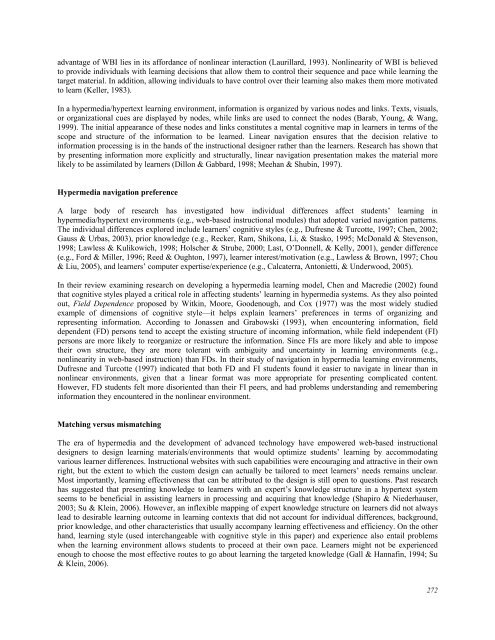The effects of web-based instruction navigation modes - Educational ...
The effects of web-based instruction navigation modes - Educational ...
The effects of web-based instruction navigation modes - Educational ...
You also want an ePaper? Increase the reach of your titles
YUMPU automatically turns print PDFs into web optimized ePapers that Google loves.
advantage <strong>of</strong> WBI lies in its affordance <strong>of</strong> nonlinear interaction (Laurillard, 1993). Nonlinearity <strong>of</strong> WBI is believed<br />
to provide individuals with learning decisions that allow them to control their sequence and pace while learning the<br />
target material. In addition, allowing individuals to have control over their learning also makes them more motivated<br />
to learn (Keller, 1983).<br />
In a hypermedia/hypertext learning environment, information is organized by various nodes and links. Texts, visuals,<br />
or organizational cues are displayed by nodes, while links are used to connect the nodes (Barab, Young, & Wang,<br />
1999). <strong>The</strong> initial appearance <strong>of</strong> these nodes and links constitutes a mental cognitive map in learners in terms <strong>of</strong> the<br />
scope and structure <strong>of</strong> the information to be learned. Linear <strong>navigation</strong> ensures that the decision relative to<br />
information processing is in the hands <strong>of</strong> the <strong>instruction</strong>al designer rather than the learners. Research has shown that<br />
by presenting information more explicitly and structurally, linear <strong>navigation</strong> presentation makes the material more<br />
likely to be assimilated by learners (Dillon & Gabbard, 1998; Meehan & Shubin, 1997).<br />
Hypermedia <strong>navigation</strong> preference<br />
A large body <strong>of</strong> research has investigated how individual differences affect students’ learning in<br />
hypermedia/hypertext environments (e.g., <strong>web</strong>-<strong>based</strong> <strong>instruction</strong>al modules) that adopted varied <strong>navigation</strong> patterns.<br />
<strong>The</strong> individual differences explored include learners’ cognitive styles (e.g., Dufresne & Turcotte, 1997; Chen, 2002;<br />
Gauss & Urbas, 2003), prior knowledge (e.g., Recker, Ram, Shikona, Li, & Stasko, 1995; McDonald & Stevenson,<br />
1998; Lawless & Kulikowich, 1998; Holscher & Strube, 2000; Last, O’Donnell, & Kelly, 2001), gender difference<br />
(e.g., Ford & Miller, 1996; Reed & Oughton, 1997), learner interest/motivation (e.g., Lawless & Brown, 1997; Chou<br />
& Liu, 2005), and learners’ computer expertise/experience (e.g., Calcaterra, Antonietti, & Underwood, 2005).<br />
In their review examining research on developing a hypermedia learning model, Chen and Macredie (2002) found<br />
that cognitive styles played a critical role in affecting students’ learning in hypermedia systems. As they also pointed<br />
out, Field Dependence proposed by Witkin, Moore, Goodenough, and Cox (1977) was the most widely studied<br />
example <strong>of</strong> dimensions <strong>of</strong> cognitive style—it helps explain learners’ preferences in terms <strong>of</strong> organizing and<br />
representing information. According to Jonassen and Grabowski (1993), when encountering information, field<br />
dependent (FD) persons tend to accept the existing structure <strong>of</strong> incoming information, while field independent (FI)<br />
persons are more likely to reorganize or restructure the information. Since FIs are more likely and able to impose<br />
their own structure, they are more tolerant with ambiguity and uncertainty in learning environments (e.g.,<br />
nonlinearity in <strong>web</strong>-<strong>based</strong> <strong>instruction</strong>) than FDs. In their study <strong>of</strong> <strong>navigation</strong> in hypermedia learning environments,<br />
Dufresne and Turcotte (1997) indicated that both FD and FI students found it easier to navigate in linear than in<br />
nonlinear environments, given that a linear format was more appropriate for presenting complicated content.<br />
However, FD students felt more disoriented than their FI peers, and had problems understanding and remembering<br />
information they encountered in the nonlinear environment.<br />
Matching versus mismatching<br />
<strong>The</strong> era <strong>of</strong> hypermedia and the development <strong>of</strong> advanced technology have empowered <strong>web</strong>-<strong>based</strong> <strong>instruction</strong>al<br />
designers to design learning materials/environments that would optimize students’ learning by accommodating<br />
various learner differences. Instructional <strong>web</strong>sites with such capabilities were encouraging and attractive in their own<br />
right, but the extent to which the custom design can actually be tailored to meet learners’ needs remains unclear.<br />
Most importantly, learning effectiveness that can be attributed to the design is still open to questions. Past research<br />
has suggested that presenting knowledge to learners with an expert’s knowledge structure in a hypertext system<br />
seems to be beneficial in assisting learners in processing and acquiring that knowledge (Shapiro & Niederhauser,<br />
2003; Su & Klein, 2006). However, an inflexible mapping <strong>of</strong> expert knowledge structure on learners did not always<br />
lead to desirable learning outcome in learning contexts that did not account for individual differences, background,<br />
prior knowledge, and other characteristics that usually accompany learning effectiveness and efficiency. On the other<br />
hand, learning style (used interchangeable with cognitive style in this paper) and experience also entail problems<br />
when the learning environment allows students to proceed at their own pace. Learners might not be experienced<br />
enough to choose the most effective routes to go about learning the targeted knowledge (Gall & Hannafin, 1994; Su<br />
& Klein, 2006).<br />
272
















